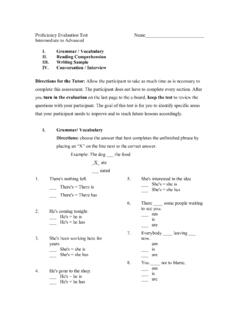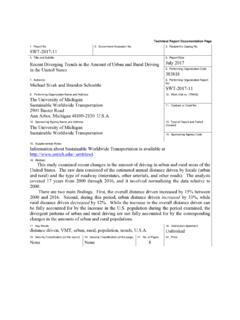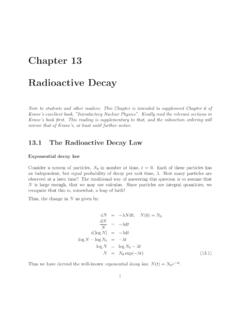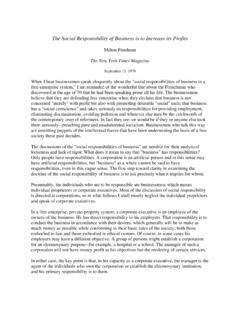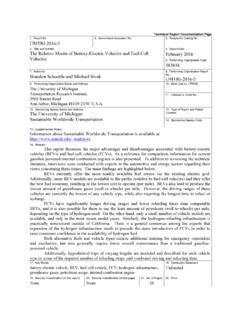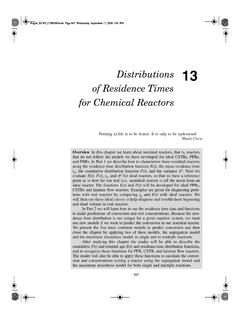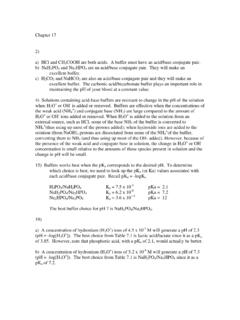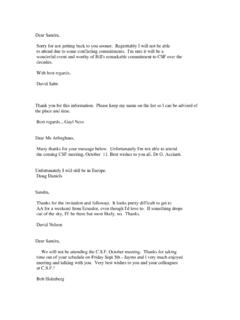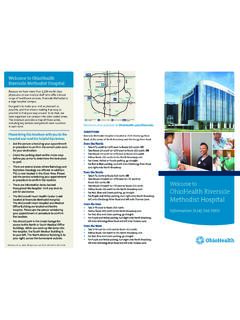Transcription of Developing a Staffing Model that Responds to Varying Flow ...
1 I Developing a Staffing Model that Responds to Varying Flow, Volume, and Acuity Final Report Submitted To: Bev Smith Nurse Manager University Hospital PACU/Pre-Op 1500 East Medical Center Driver Ann Arbor, MI 48109 Noreen Myers Clinical Manager University Hospital PACU 1500 East Medical Center Driver Ann Arbor, MI 48109 Sharon Rombyer Clinical Manager University Hospital PACU 1500 East Medical Center Driver Ann Arbor, MI 48109 Professor Mark Van Oyen Associate Professor University of Michigan Industrial and Operations Engineering Department 1205 Beal Avenue Ann Arbor, MI 48109 Submitted By: Team 8 Phil Allen Margot Smith Rob Whitaker Date Submitted: December 9, 2014 ii Table of Contents Executive Summary .. 1 Methodology .. 1 Findings and Conclusion .. 2 2 Introduction.
2 3 Background .. 3 Project Goals and Objectives .. 4 Key Issues .. 5 Project 5 Methodology .. 5 Literature Search .. 5 Interviews .. 6 Time Studies .. 6 Historical Data .. 6 Beeper Study .. 7 Findings and Conclusions .. 8 Patient Activity .. 8 Nurse 9 Nurse to Patient Ratios .. 10 Staffing Model .. 14 Recommendations .. 14 Staffing Model .. 14 Beeper Study .. 14 Expected Impact .. 15 Appendix .. 16 iii List of Figures and Tables Figure 1 .. 8 Figure 2 .. 9 Figure 3 .. 9 Figure 4 .. 10 Figure 5 .. 10 Figure 6 .. 11 Figure 7 .. 11 Figure 8 .. 12 Figure 9 .. 12 Figure 10 .. 13 Table 1 .. 13 1 Executive Summary The PACU at University of Michigan Health System is divided into three different phases of care: pre-operative care, Phase 1 and Phase 2. Patients in Pre-Op are pre- surgery , while Phase 1 and Phase 2 are post- surgery patients, with Phase 1 patients requiring a higher level of care than Phase 2 patients.
3 The pre-operative care area is staffed at a 1:3 nurse to patient ratio, although the nurse manager and clinical managers indicated that the pre-operative care nurses feel understaffed because of the large variances in flow, volume, and acuity. Flow is defined as the availability of slots and staff within the PACU, as well as the care associated with admission and discharge. The American Society of Perianesthesia Nurses (ASPAN) standards for Phase 1 and Phase 2 areas of the PACU are staffed at 1:2 and 1:3 nurse to patient ratios respectively. The PACU currently uses a scheduling Model that determines the number of nurses needed for an average daily census of 73 patients, as well as the number of shifts, length, and start time needed for the schedule eight weeks in advance. PACU employees consist of nurses, a clinical care coordinator, two nurse education coordinators, clinical nurse specialist, assistive personnel and clerks that are supervised by nurse and clinical managers.
4 The PACU also uses a Staffing Model to determine the total number of full-time equivalent nurses (FTE s) needed to be hired. Currently, there are 59 FTE s nurses who are assigned to shifts in pre-operative care, pre-operative phone calls, Phase 1, and Phase 2. The PACU is at times understaffed. This could be due to the nurse to patient ratios needing updates, employee turnover, and staff levels between current Model FTE totals. This can cause the staff in the PACU to feel over-utilized. Methodology The team developed an updated PACU Staffing Model by using staff interviews and historical data, performing a beeper study, performing a literature search, then analyzing data, and giving recommendations. The team interviewed the PACU staff in order to understand the problems they felt the PACU was facing, as well as any feelings of frustration towards Staffing or PACU processes.
5 The historical data, of nearly 400 cases, allowed the team to analyze admit and discharge times for every patient from the fiscal year 2014 in order to see how many patients are being admitted, cared for, and discharged every hour or every day. The beeper study, of over 700 data points, identified the types and frequencies of activities that the PACU nurses spend time on. It also provided the team with actual nurse to patient ratios, which will be compared to the ratios that are used in the Staffing Model . The literature search gave the team context as to problems that occur within the PACU. 2 Findings and Conclusions From the historical data, the average number of patients being admitted, cared for, and discharged each hour was determined. Additionally, the average number of patients, or average number of beds in use, in the PACU, Pre-Op, Phase 1, and Phase 2, each hour of each day for the fiscal year of 2014 was determined along with the 80th percentile, which is standard practice.
6 The beeper study data led to the conclusion that the previous nurse to patient ratios, for Pre-Op, for Phase 1, and for Phase 2, were needing updating. Nurses were asked to mark the level of care they were providing, and also if they had bandwidth to care for more patients. From the analysis of responses, the ideal nurse to patient ratios for Pre-Op, Phase 1, and Phase 2 within the PACU were , , and respectively. This was an increase in nurse to patient ratios in Pre-Op and Phase 2, but a decrease for Phase 1. The Staffing Model was updated using the updated Pre-Op and Phase 2 nurse to patient ratios, but leaving the Phase 1 nurse to patient ratio as it was previously. Additionally, the average number of patients in the PACU each hour in Pre-Op, Phase 1, and Phase 2 was updated from the findings in the historical data.
7 The Model indicated that the total number of direct care full-time equivalents to hire should be 64 FTE s, an increase of 1 FTE from the previous year. Recommendations The team recommends that the new Staffing Model be used. The team determined the implementation of the updated Staffing Model was the most important recommendation after discovering that the nurse to patient ratios from the fiscal year of 2014 were not up to date based on the ratios acquired from the beeper study. Based on the Staffing Model , the team recommends that 1 more FTE be hired in order to meet the demands of the PACU. With the hiring of more staff, the peak periods of admission and care for the Pre-Op and PACU can be staffed at a higher ratio so that nurses do not feel as overworked. Additionally, with the increase in number of staff, the time spent on admissions in both the Pre-Op and PACU should decrease so more time can be spent on care and charting, the two activities requiring the most of a nurse s time.
8 3 Introduction The Postanesthesia Care Unit (PACU) at the University of Michigan Health System (UMHS) is located outside of the Operating Room (OR). The PACU provides care for patients recovering from anesthesia, whether from surgery or another procedure, as well as pre-operative care to prepare patients to receive anesthesia. The nurse manager and clinical managers have expressed concerns that the current Staffing Model is outdated. Nurses in the PACU at times feel understaffed. The American Society of Perianesthesia Nurses (ASPAN) has standards for nurse to patient ration in PACU Phase I and PACU Phase II, but no Staffing Model based on patient acuity. To address these problems, the nurse and clinical managers in the PACU asked an IOE 481 student team from the University of Michigan College of Engineering to develop an updated Staffing Model using patient volume, flow into and out of the Pre-Op/PACU, and patient acuity.
9 The team analyzed data from past PACU activity, performed time studies and interviewed staff to develop an updated and effective Staffing Model for the unit. Additionally, the team collected and analyzed data related to patient flow on a given week and the corresponding times of the day. Background The PACU at University of Michigan Health System is divided into three different phases of care: pre-operative care, Phase 1 and Phase 2. Patients in Pre-Op are pre- surgery , while Phase 1 and Phase 2 are post- surgery patients, with Phase 1 patients requiring a higher level of care than Phase 2 patients. Patients entering the PACU are designated into three types. First, hospital outpatient surgery patients come from home the day of surgery and go home that day after surgery . Second, surgery admits come from home the day of surgery then are admitted to the hospital after surgery .
10 Lastly, in-patients are already at the hospital before surgery and then go back to a hospital bed after surgery . Three nurses each day are staffed for pre-operative phone calls where they call all the patients who are receiving surgery the following day and give them instructions. Patients are asked to arrive two hours before their scheduled surgery and they are admitted to the PACU to receive pre-operative care for approximately to 2 hours. The pre-operative care area is staffed at a 1:3 nurse to patient ratio. The nurse manager and clinical managers indicated that the pre-operative care nurses feel understaffed because of the large variances in flow, volume and acuity. Flow is defined as the availability of slots and staff 4 within the PACU, as well as the care associated with admittance and discharge.
